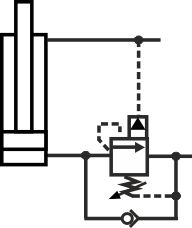Understand counterbalance and load control valve design features, specification and performance limits.
Self-study lesson plans and training record download page.
3 Tips for operating and maintaining

Load holding applications are covered by the LOLER regulations whereby every new build or repair needs to be checked that the load does not fall more than a set amount of a given period.
The small flows in pilot lines often require very small damping orifices, sometimes smaller than 0.8mm, if the flow is in both directions. However, small orifices will increase the risk of blocking due to contamination.
With regenerative circuits or proportional valves, there is often no clearly vented pressure on the downstream side of the valve which feeds the counterbalance pilot. This can have the effect of stopping the valve closing properly and therefore leaving the valve open to unsafe oscillations.
Although not very scientific, if you do have an instability problem with a counterbalance valve then the best approach is often just to try a number of different valves from the same or other manufacturers. Oil Control and Sun Hydraulics both have good reputations for producing stable valves.
3-4 Design features and operating characteristics
Counterbalance valves have the same poppet, spool, spring and orifice elements as pressure relief valves and therefore exhibit the same performance features. These design factors still apply to counterbalance valves and have already been covered in the relief valve training section so will not be covered again here.
3-4 How to specify counterbalance or load control valves
1. Select a valve with an appropriate, nominal flow rate to suit your application.
2. Select a relief valve pressure setting 30% higher than the maximum induced load.
3. Select a pilot ratio (Start with 3 or 4:1) and calculate the pilot pressure required to start lowering the load based on the manufacturer's recommended calculation for your application. e4training.com has a pilot cracking pressure calculation pilot pressure calculator to assist this here. Select a higher pilot ratio if you need to open the valve more quickly, at a lower pressure, and achieve better energy saving.
4. Check there will be no backpressures that can affect the control springs. Select an appropriate externally vented valve if required to avoid this. An additional pilot vent line would be preferable, if costs allow, particularly for regen or proportional control circuits.
5. If you are lowering particularly high or safety critical loads then it may be worth considering the more restrictive versions available with some models.
6. Consider pilot damping options or allow the facility to tweak later if this application has never been tried before.
7. If you get instabilities during first off testing then swap your valve and try a different type.
4 Design Tips, techniques and potential issues
Other tips for selecting counterbalance valves are covered in the load control of this site here. With such specialist valves, we also recommend discussing your application with the valve manufacturer's engineers and perhaps trying different valves in the actual equipment to see which one works best.